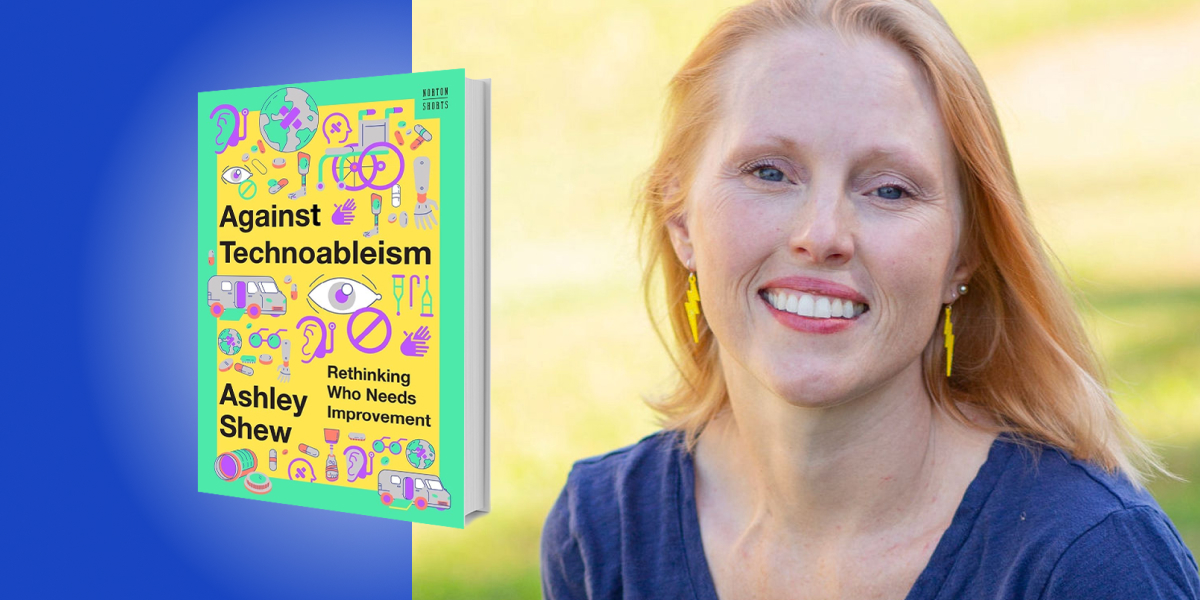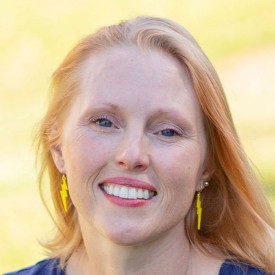Ashley Shew is an associate professor of science, technology, and society at Virginia Tech, and specializes in disability studies and technology ethics.
Below, Ashley shares 5 key insights from her new book, Against Technoableism: Rethinking Who Needs Improvement. Listen to the audio version—read by Ashley herself—in the Next Big Idea App.

1. What you think you know about disability is probably wrong.
The stories you have heard about disability have likely given you a misperception. As someone who became disabled at age 30, even though I thought I knew a lot of things, I was not really aware of how every day would be. I remember being shocked when no one came to help a wheelchair-using friend who was parked-in with her lift-equipped van, but disabled people are much more accustomed to having to figure things out themselves than anyone is typically credited for.
My presumption was that there were support systems in place. But they simply don’t exist. Disabled people are forced to navigate hostile waters among do-gooders who simply don’t understand our experiences. I know I didn’t always get it.
2. You have to be wary of common tropes around disability.
So often the stories that are told about disability emphasize regular tropes or biases. Five common narrative tropes are pitiful freaks, shameful sinners, moochers and fakers, bitter cripples (villains), and inspirational overcomers.
With a trope like moochers and fakers at play, disabled people are policed when we use disability services, parking, and other accommodations. Many news stories paint ADA (Americans With Disabilities Act) lawsuits as frivolous, even though they are rare and difficult to win. This trope leads to many disabled people being afraid to use things that would help them —like extra time on tests in an educational setting or disability parking—because it makes people scrutinize them so much more.
“Bewareness can lead to people being more afraid of the disability than before.”
The trope of pitiful freaks plays out in many of the narratives told by supposedly charitable organizations that paint particular disabilities as awful and pitiful, calling for your intervention and help. Charitable events like the Muscular Dystrophy Association’s long-running telethons or advertising like that of Autism Speaks have often spread messages about their respective target group that some people call bewareness. Bewareness can lead to people being more afraid of the disability than before. Disability activists have protested the MDA and Autism Speaks because of these tactics.
With the trope of bitter cripples, depictions of villains involve things like facial scars and hook prosthetic hands indicate how twisted the disabled character is. This is a long-running trope that precedes modern cinema. The result though, is that hand amputees are less likely to use very useful hook tools because children find them frightening. These tropes end up setting the scene upon which disabled people are encountered and misunderstood.
3. Narrative tropes end up dominating the conversation, even when we’re talking about technology stories.
The tropes regarding disability don’t give a realistic image of what being disabled is like. They are often stories curated to please non-disabled people or encourage the newly disabled (from a nondisabled perspective). So many stories about disabled people start with these different tropes or biases as the frame from which they see disabled people.
We are almost always represented as lone disabled individuals, separate and separated by each other. But we know cross-disability friendship and collaboration improve the lives of disabled people, and witnessing this on screen or in the news is almost impossible. Even the story of Helen Keller, which is usually told only about her youth, depicts Annie Sullivan as a miracle worker. The biographical movie about Helen Keller is literally called The Miracle Worker— Helen doesn’t get to be the headline of her own story. But it elides the fact that Annie Sullivan is legally blind, and the two were lifelong friends.
4. The disability community isn’t what you think.
The disability community isn’t just one thing, it’s huge and intersectional. Countless stories from non-white disabled are often left untold. Most disabled people have multiple disabilities, yet the tendency for most stories is to have a disabled person with only one disability.
“A lot of things that benefit disabled people only benefit white disabled users.”
Even new stories about new tech often feature white tech users only. This means that disabled people of color are often underserved—meaning that a lot of things that benefit disabled people only benefit white disabled users. Disabled history often overlooks the incredible role Black, Indigenous, and Asian disabled people played during the disability civil rights era. There were disabled Black Panthers who were a critical force in disability organizing during the 504 sit-ins, some of the longest sit-ins in American History. During the ADA30 Celebration, Alice Wong and her team brought together ADA30 In Color, to let disabled people of color talk about the anniversary. At the event, attendees discussed how the main beneficiaries of the Americans with Disabilities Act were more financially secure white disabled people.
5. Disabled people are inventive and deserve appreciation beyond trope-y nonsense.
Our stories are much more nuanced and sometimes in-your-face, and they are not aimed at pleasing nondisabled people. We build and invent for each other and for ourselves. Disabled creativity shows up in different art movements, but also in how we tell our own stories and what we make for ourselves and each other.
I’m continually learning new life skills: learning about hearing aid skins that I can buy from other disabled people on Etsy to make my hearing aids fancy, learning from my friends with ADHD on how to use the alarms on my phone to show up on time for things, learning from neurodivergent and chronically ill folks about thinking more flexibly and forgivingly about time and productivity (to value my body and mind, and respect their boundaries); and so much more. We learn about new tech, and repurpose technologies for our own use, and maintain older tech, together.
I tell my classes that ableism is the sauce we’re all marinated in. Part of my work with Against Technoableism is to force recognition of certain forms of ableism that seem so prevalent, especially in the sphere of technology where technologies are often celebrated as cure-alls for disability. But these stories about technology and disability often do a disservice to disabled people, taking away recognition of our agency, autonomy, and, frankly, being seen as regular people, which is what we are.
To listen to the audio version read by author Ashley Shew, download the Next Big Idea App today:































